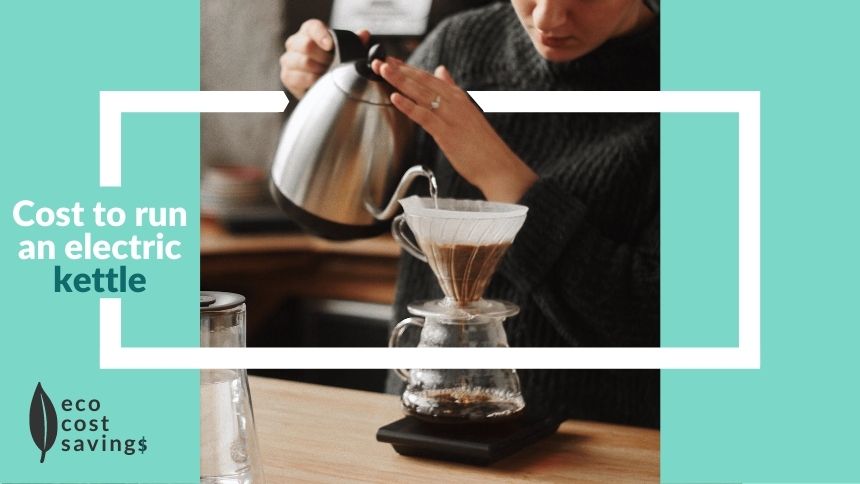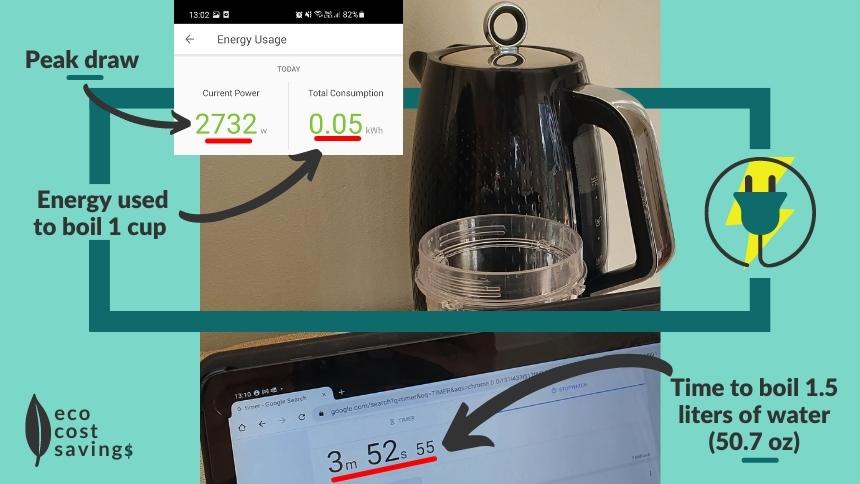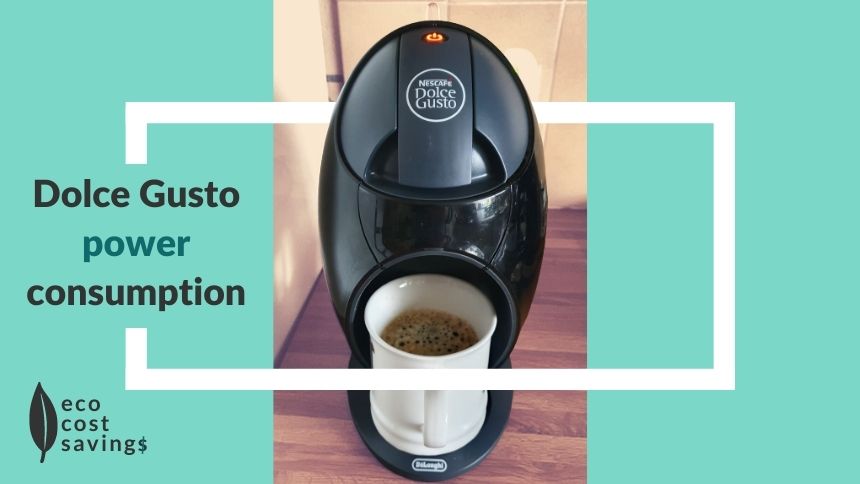Last updated: January 28, 2024.
How much electricity does a kettle use? Find out below, and see how much they cost to boil, and get 7 tips that’ll keep your costs low.
Electric kettles are notorious energy guzzlers. But how much do they actually cost to run?
Spoilers:
- A typical electric kettle consumes 0.05 kWh of electricity to boil 1 cup of water, and 0.17 kWh to boil 1.5 liters (50.7 oz);
- Taking user behavior into account, the most common amount of electricity a kettle consumes per boil is 0.073 kWh;
- On average, in the US, it costs 1 cent to boil a typical electric kettle. This equates to $1.75 per month, if using an electric kettle as much as UK users; and
- In the UK, it costs 2 cents (£0.016) to boil an electric kettle, on average. This works out to $3.07 (£2.49) per month for a typical UK household.
Continue reading to see how much it costs to boil one cup, and 1.5 liters (50.7 oz) of water. Plus, use the Kettle Electricity Cost Calculator to see your own specific costs.
Also below, we take a look at how the US, and UK compares to 38 other countries in terms of electric kettle running costs. Additionally, you’ll get 7 quick tips for reducing your electric kettle running costs, along with details about the environmental impact from running electric kettles.
Update: Energy prices have fluctuated considerably, so an Electric Kettle Electricity Cost Calculator has been introduced below, which enables you to make more accurate running cost estimates – simply input the price you pay per kWh, and see your cost per boil, etc.
But first, how much energy does an electric kettle consume?

Electric kettle energy use
The amount of water you want to boil, its temperature, your kettle’s wattage and efficiency, are some of the many factors that impact how much energy electric kettles consume.
As a result, when working out how much energy electric kettles use, many people reference electric kettle maximum ratings or simply use a note by a now closed UK utility company (npower), which states that: it takes 3 minutes to boil 1.5 litres of water (i.e. what an average kettle holds), which results in approximately 0.1 kWh of electricity consumed.
But is this still accurate? Let’s run some tests.
How much electricity does a kettle use? (Test results)
An electric kettle consumes 0.05 kWh of electricity to boil 1 cup (8 oz / 236.6 ml) of water, and 0.17 kWh to boil 1.5 liters (50.7 oz). The most common amount of electricity a kettle consumes is 0.073kWh per single use, taking user behavior into account.

I tested the power consumption of a standard electric kettle using an energy monitor. Here are the results:
- Boiling 1 cup of water (8 oz / 236.6 ml) consumed 0.05 kWh of electricity, and took 58 seconds;
- Boiling 1.5 liters of water (50.7 oz) used 0.17 kWh, and took 3 minutes and 53 seconds; and
- While boiling, the electric kettle consumed 2,732W of electricity at its peak.
Note: the kettle used during these tests had a typical power rating of “2550-3000W.”
Very specific water volumes were used in these tests. But people don’t tend to fill their kettles with very specific amounts of water, so let’s look at more realistic behavior.
A study by Murray et al. (2016), “Understanding usage patterns of electric kettle and energy saving potential”, provides insight into real-world behavior.
They recorded actual electrical kettle consumption levels from various households, with varying occupancy levels. As a result, we can take behavior into account to give us a more accurate estimation of how much power electric kettles consume:
Electric kettles consume on average .073kWh per single use.
This is more than the amount of electricity consumed when boiling enough water for one cup because overfilling is common.
The table below summarizes how much electricity an electric kettle uses:
| Electricity used per cup (8 oz / 236.6 ml) | Electricity used per boil (most common) | Electricity used per 1.5 liters (50.7 oz) | |
| Electric kettle power consumption | 0.05 kWh | 0.073 kWh | 0.17 kWh |
So with this in mind let’s take a look at how much it costs to boil an electric kettle.
How much does an electric kettle cost to boil?
Taking the average electric kettle consumption of .073kWh, and the average price per unit of electricity, we can work out how much it costs to boil an electric kettle.
In the US, it costs just over $0.01 to boil a typical electric kettle, on average.
In the UK, on average, it costs 2 cents (£0.016) to boil an electric kettle.
The table below shows how much it costs to boil a kettle with 1 cup of water, the most common amount of water, and 1.5 liters of water (50.7 oz).
| Cost per cup (8 oz / 236.6 ml) | Cost per boil (most common) | Cost per 1.5 liters (50.7 oz) | |
| Cost to boil a kettle in the US | $0.008 | $0.0117 | $0.0272 |
| Cost to boil a kettle in the UK | $0.014 | $0.02 | $0.0476 |
These costs assume an average unit rate in the US and UK (as of early 2022).
Related – to see how much a toaster costs per use, check out: Toaster Wattage Results [Lowest Wattage & Cost Per Use Revealed].
To work out your own running costs, use the Kettle Electricity Cost Calculator below.
Kettle Electricity Cost Calculator
Use the Kettle Electricity Cost Calculator below to estimate how much it costs you to boil 1 cup, and 1.5 liters (50.7 oz) of water.
Simply enter the price you pay per kWh.
These results are based on the electric kettle power consumption test results above.
Also, it’s worth noting that the cup size is the typical American cup size, specifically 8 oz / 236.6 ml, as opposed to the UK’s 250 ml.
The calculator is pre-populated with the average unit rate in the US.
Arguably, the calculator should be pre-populated with UK averages, because it’ll likely be used more by UK readers.
Electric kettles aren’t as common in the US compared to the UK.
There are many behavioral / cultural reasons for this. But one of the more interesting, and relatively unknown reasons is to do with the different voltages (V). The US uses 110V, while the UK is 230V. As a result, electric kettles take longer to boil in the US compared to the UK.
Over 90% of people in the UK use a kettle every day. A whopping 40% use a kettle 5 times or more, per day!
So at 5 times per day, let’s take a look at how much it costs per month to boil an electric kettle in the US and UK.
Electric kettle running costs per month
Let’s assume the US is as addicted to the kettle as the UK. Taking the UK’s 5 times per day usage, we can quickly work out how much it costs per month to boil an electric kettle.
In the UK, it typically costs $3.07 (£2.49) per month to boil an electric kettle.
In the US, it costs $1.75 per month in electricity to run an electric kettle at the same rate as they do in the UK.
But what about the many other countries around the world? How does the US, and UK compare?
Electric kettle running costs by country
Let’s take the average 0.073kWh electric kettle consumption, typical UK usage amount and the average unit price of electricity for each country (source: Statista 2024, 2023, 2022 & 2021), and see how much it costs to boil an electric kettle once, and for a full month.
| Country | Average kWh price in USD | Electric Kettle Cost Per Use (USD) | Cost p/m at typical UK use (i.e. 5 times p/d) |
| Denmark | $0.36 | $0.03 | $3.94 |
| Germany | $0.35 | $0.03 | $3.83 |
| Belgium | $0.28 | $0.02 | $3.07 |
| United Kingdom | $0.28 | $0.02 | $3.07 |
| Venezuela | $0.27 | $0.02 | $2.96 |
| Portugal | $0.26 | $0.02 | $2.85 |
| Spain | $0.26 | $0.02 | $2.85 |
| Ireland | $0.26 | $0.02 | $2.85 |
| Rwanda | $0.25 | $0.02 | $2.74 |
| Japan | $0.24 | $0.02 | $2.63 |
| Austria | $0.23 | $0.02 | $2.52 |
| Italy | $0.23 | $0.02 | $2.52 |
| Australia | $0.23 | $0.02 | $2.52 |
| Kenya | $0.22 | $0.02 | $2.41 |
| New Zealand | $0.21 | $0.02 | $2.30 |
| Sweden | $0.21 | $0.02 | $2.30 |
| France | $0.20 | $0.01 | $2.19 |
| Colombia | $0.18 | $0.01 | $1.97 |
| Netherlands | $0.18 | $0.01 | $1.97 |
| Poland | $0.18 | $0.01 | $1.97 |
| South Africa | $0.18 | $0.01 | $1.97 |
| Singapore | $0.18 | $0.01 | $1.97 |
| Finland | $0.17 | $0.01 | $1.86 |
| Chile | $0.17 | $0.01 | $1.86 |
| Israel | $0.17 | $0.01 | $1.86 |
| Brazil | $0.16 | $0.01 | $1.75 |
| United States | $0.16 | $0.01 | $1.75 |
| Canada | $0.11 | $0.01 | $1.20 |
| Indonesia | $0.10 | $0.01 | $1.10 |
| South Korea | $0.10 | $0.01 | $1.10 |
| China | $0.09 | $0.01 | $0.99 |
| Mexico | $0.09 | $0.01 | $0.99 |
| India | $0.08 | $0.01 | $0.88 |
| Turkey | $0.06 | $0.0044 | $0.66 |
| Nigeria | $0.06 | $0.0044 | $0.66 |
| Russia | $0.06 | $0.0044 | $0.66 |
| Saudi Arabia | $0.05 | $0.0037 | $0.55 |
| Qatar | $0.03 | $0.0022 | $0.33 |
| Ethiopa | $0.01 | $0.0007 | $0.11 |
| Iran | $0.01 | $0.0007 | $0.11 |
As expected, many EU countries and the UK top the table of most expensive countries to boil an electric kettle. Followed closely behind in 5th spot by Venezuela.
It costs 2 cents or more (rounded to the nearest decimal place) to boil a kettle for nearly half of the countries listed in the table.
The US and Canada are 2 of 16 countries in our list of 40, where it costs 1 cent (USD) to boil an electric kettle.
It costs under 1 cent for 7 countries, including Saudi Arabia and Qatar, to boil a kettle.
The UK is the 4th most expensive county to run an electric kettle. An unfortunate position given the rate of use.
Interestingly, on average in the UK, electric kettles account for approx. 4% of an average household’s total energy consumption.
How to reduce electric kettle running costs
There are ways that you can minimize your energy consumption while keeping your electricity bills low. Below, I’ve listed 7 easy tips to reduce the cost of boiling your electric kettle.
7 tips to reduce the cost of boiling water in a kettle
- Let’s get this one out of the way first: use your electric kettle, or any kettle, less. This is the quickest and most effective way to keep your running costs low. 80% of the environmental impact from your electric kettle is caused by its usage. Interestingly, the manufacturing of electric kettles makes up less than 4% of the impact, while transportation represents 1%.
- Only boil what you need. Do not fill your kettle up more than is necessary (but be sure to fill it up to at least the manufacturer’s minimum stated level). The more water you put into a kettle, the longer it takes to boil. This increases energy wastage and will increase your energy bills. Only boiling what you need will reduce the environmental impact from running your kettle by roughly 1/3. If you want to boil one cup of water, consider filling that cup up with water, and pour it into the kettle so there’s no wastage. But again, make sure the water level reaches the kettle’s mininum stated level.
- Steer away from using an electric hob/stovetop. Electric kettles are insulated, and their heating element is in closer contact with the water. As a result, they are more efficient, so it will cost you less to boil water compared to an electric hob/stovetop. Hot plates or induction stovetops can, however, be slightly more efficient than electric kettles when used effectively.
- Consider using gas. Gas hob stoves can bring water to a boil more cost effectively, even compared to electric kettles. This does, however, depend on the quality of kettles used, but given that gas prices in most countries are usually significantly lower than electricity, it could cost you less to boil water on a stove hob.
- Keep your kettles running efficiently. Check for build up on your electric kettle’s heating element and consider descaling. Check the bottom of your stovetop kettle for build up. And make sure your kettle’s lid closes properly to avoid an excess amount of heat escaping.
- Consider switching between energy providers. Usually energy providers have special offers to encourage switching. This can be a really effective way at reducing the cost of boiling a kettle.
- Finally, don’t heat water more than is necessary. Modern electric kettles, such as this best seller, have temperature controls. Not only can this reduce your costs, but you may also select the optimal temperature for your brew. Controlling the water temperature can reduce the environmental impact of your kettly by 2%–5%.
Eco impact
Electric kettles are notorious energy guzzlers. You may or may not be surprised at how much they cost to run. But if you use them as much as 40% of the UK does, then you may be brewing (kettle pun) up a storm. The cost of running a kettle once may not be substantial, but over a 2 month billing period this could get considerable.
As a whole, however, the impact on the environment from kettles is considerable. An estimated 19.5-33.3 TWh of electricity is consumed in the EU, each year, to power electric kettles.
In Britain, overfilling kettles alone wastes GBP68 million each year in electricity, and 3,525 tonnes of CO2 every day. The CO2 wasted per year (1,286,625 tonnes) from overfilling kettles is equivelant to over 250,000 passenger vehicles driven for one year. To put it another way, it would take over 19,000,000 tree seedlings grown for 10 years to remove this wasted CO2.
So do consider the energy saving tips above, if not for your pocket, then for the environment.
By the way, compared to the average power consumption of boiling a kettle, Dolce Gusto coffee machines consume less than half of the power. But does that mean they’re more efficient?
Get details about Dolce Gusto power consumption and electricty cost per cup, here.
Don’t miss Coffee Makers vs Electric Kettles.
-
Coffee Maker Wattage & Efficiency [Top 117 Compared | 2024]
See the most energy efficient coffee makers, running costs & the average coffee maker wattage based on 117 of the top selling machines. Plus, get 5 cost saving tips here.
-
Dolce Gusto power consumption and electricity cost per cup
Every wonder what the electricity cost of a coffee is from a Dolce Gusto? I did. Get a breakdown of the power consumption and electricity cost per cup here.
-
Cost Of Running A Refrigerator [9 Cost Saving Tips + Most Efficient Revealed]
How much electricity does a fridge use? You’ll find out here. Plus you’ll see how much it costs to run a refrigerator (US & UK), and you’ll get 9 cost saving tips.
James, Eco Cost Savings co-founder and Editor-in-Chief, is also our experienced in-house energy management and sustainability expert, and manager of our network of sustainability consultants.
Before his journey into sustainability, James studied engineering. Additionally, he has experience in HVAC installation, and data analysis. A self-proclaimed practical environmentalist, and avid penny pincher, James established Eco Cost Savings to share his and his colleague’s expertise with the aim of helping to reduce energy bills and carbon footprints at scale.

![Coffee Maker Wattage & Efficiency [Top 117 Compared | 2024]](https://ecocostsavings.com/wp-content/uploads/2021/07/coffee-maker-wattage.jpg)

![Cost Of Running A Refrigerator [9 Cost Saving Tips + Most Efficient Revealed]](https://ecocostsavings.com/wp-content/uploads/2020/10/cost-to-run-refrigerator.jpg)